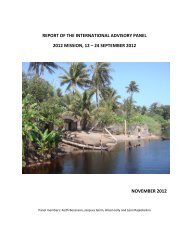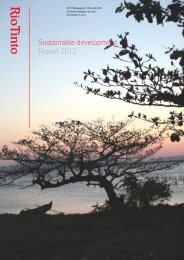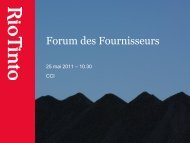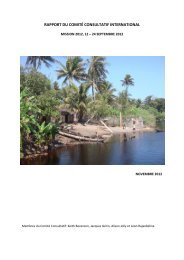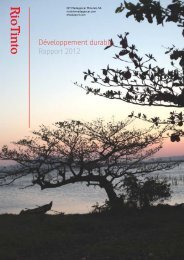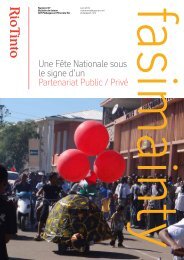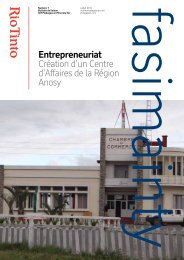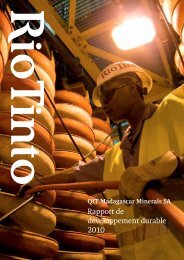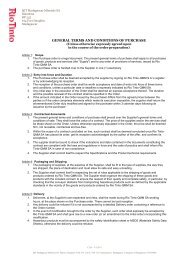Correspondence Between Vernacular and Scientific Names of ...
Correspondence Between Vernacular and Scientific Names of ...
Correspondence Between Vernacular and Scientific Names of ...
Create successful ePaper yourself
Turn your PDF publications into a flip-book with our unique Google optimized e-Paper software.
07_MadagascarRevisions_R4 3/7/08 3:38 PM Page 96<br />
types <strong>of</strong> botanical research since 1990, including the<br />
collection <strong>of</strong> voucher specimens. During the course<br />
<strong>of</strong> these collections, local botanical experts were<br />
able to provide vernacular names associated with<br />
specimens in h<strong>and</strong>. Further, certain names have been<br />
taken from published papers <strong>and</strong> student theses<br />
(R<strong>and</strong>riatafika 2000, Ralison 2001, Bollen 2003).<br />
Information was also obtained from the Missouri<br />
Botanical Garden's TROPICOS database<br />
(http://mobot.mobot.org/W3T/Search/vast.html).<br />
Taxonomy follows Schatz (2001).<br />
List choices<br />
Tables 1 <strong>and</strong> 2 are based on knowledge <strong>of</strong> vernacular<br />
names using the various compilations <strong>and</strong> information<br />
available. The vast majority are from the<br />
Tanosy dialect <strong>of</strong> southeastern Madagascar. Species<br />
whose common names are not known do not appear<br />
on the list. Since most <strong>of</strong> the species found in the<br />
Tolagnaro littoral zone can also be found at times in<br />
other types <strong>of</strong> ecosystems, surveys were conducted<br />
in collaboration with villagers to check the corresponding<br />
vernacular names <strong>and</strong> to reduce inconsistencies.<br />
Lists<br />
We list the binomial nomenclature <strong>and</strong> common<br />
names <strong>of</strong> 519 different plant taxa. To enhance the<br />
utility <strong>of</strong> the lists, they are first presented alphabetically<br />
by binomial name (Table 1) <strong>and</strong> then alphabetically<br />
by vernacular name (Table 2).<br />
In some cases, there is a close correspondence<br />
between the binomial <strong>and</strong> vernacular name, with the<br />
former being derived from the latter. For example,<br />
Intsia bijuga (Fabaceae) is commonly called hintsy<br />
in various places on Madagascar. The same holds<br />
true for the ravinala, which corresponds with<br />
Ravenala madagascariensis (Strelitziaceae).<br />
In other cases, although there may be differences<br />
in morphological traits, a common name usually corresponds<br />
to a generic name. This is the case, for<br />
example, with n<strong>of</strong>otrakoho, which is used for four<br />
different species <strong>of</strong> Vitex (Lamiaceae). Sometimes<br />
qualifying adjectives are tagged onto the root <strong>of</strong> the<br />
name to differentiate the species, such is the case<br />
with fanolamena (mena = red) <strong>and</strong> fanolafotsy (fotsy<br />
= white). The former corresponds to Asteropeia<br />
micraster <strong>and</strong> the latter to A. multiflora<br />
(Asteropeiaceae). This is also the case with fontondahy<br />
(dahy derived from lahy = man) (Leptolaena<br />
pauciflora; Sarcolaenaceae) <strong>and</strong> fontombavy (bavy<br />
derived from vavy = woman) (L. delphinensis). A<br />
common name may also correspond to a family<br />
name, for example nanto is the name used for all<br />
species <strong>of</strong> Sapotaceae. In some cases, several common<br />
names correspond to the same Latin name:<br />
arambilo, hetatra <strong>and</strong> harambilo refer to Podocarpus<br />
madagascariensis (Podocarpaceae), <strong>and</strong> bamby <strong>and</strong><br />
babo both correspond to Anthostema madagascariensis<br />
(Euphorbiaceae). Other examples include<br />
Diporidium ciliatum (Ochnaceae), which is known<br />
as sakaimboalavo, <strong>and</strong> lona, or Buxus madagascarica<br />
(Buxaceae) may be both hazomboanjo <strong>and</strong><br />
soazanahary. Conversely, Homalium planiflorum<br />
<strong>and</strong> Ludia antanosarum (Flacourtiaceae) correspond<br />
to the same name, zorafotsy.<br />
Discussion<br />
Aspects <strong>of</strong> the etymology <strong>of</strong> the vernacular names<br />
tabulated during the course <strong>of</strong> this project led to a<br />
certain heterogeneity that is <strong>of</strong>ten due to the style <strong>of</strong><br />
information transmission <strong>and</strong> recording. The following<br />
points should be highlighted:<br />
• The different spellings for a common name vary<br />
depending on the region, location, dialect, <strong>and</strong><br />
person using it.<br />
• There is a certain level <strong>of</strong> variation in common<br />
names from the same region for the same plant.<br />
• The list <strong>of</strong> common names is an important tool to<br />
facilitate plant identification, but it cannot be<br />
considered a determining factor in assigning a<br />
binomial name.<br />
• In order to properly identify plants, it is always<br />
recommended that voucher samples be collected<br />
<strong>and</strong> identified using herbaria collections.<br />
The contribution over the past decade <strong>of</strong> the local<br />
population living near the research sites has been a<br />
key factor in the advancement <strong>of</strong> several different<br />
projects. The lists presented herein <strong>of</strong> common<br />
names for different plant taxa is thus a fundamental<br />
tool in enabling scientists <strong>and</strong> technicians to optimize<br />
collaborative work with villagers. In a regional<br />
framework, these tabulations may help managers,<br />
village associations, <strong>and</strong> decision-makers when<br />
drafting reports <strong>and</strong> documents relating to the sustainable<br />
management <strong>of</strong> natural resources.<br />
96 ■ Biodiversity, Ecology <strong>and</strong> Conservation <strong>of</strong> Littoral Ecosystems in Southeastern Madagascar, Tolagnaro




